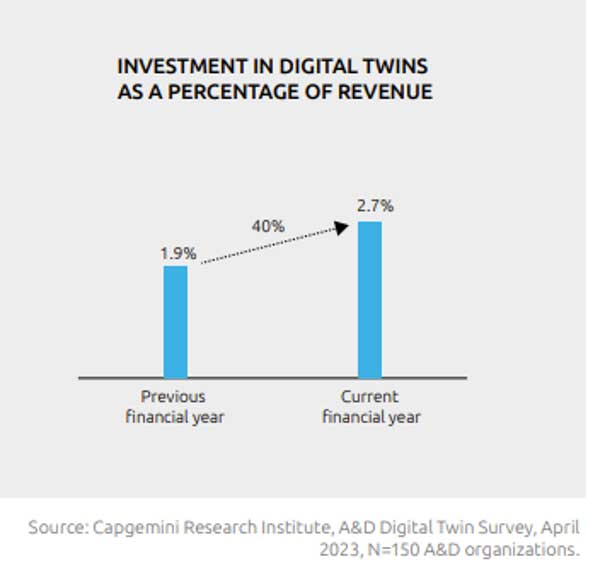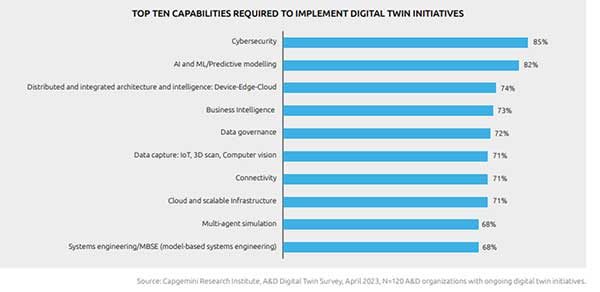These five digital infrastructure pillars will accelerate future transformation.
By: Sean Moore, Head of Aerospace and Defense Market Unit, Capgemini Americas
The growth of complex technologies – artificial intelligence (AI), the metaverse, the Internet of Things (IoT), digital twins, and more – has offered enterprises across industries new and innovative ways to stay competitive in a constantly evolving market.
In the aerospace and defense (A&D) industry, these technologies are emerging as increasingly important differentiators for solving industry challenges such as supply chain disruption, labor shortages, and regulatory compliance requirements.
The technology making the biggest splash in this industry is digital twins, which use real-world data to run simulations and predict likely outcomes, seamlessly blending the physical and digital landscapes together. In fact, new research shows that A&D investments in digital twins has increased by 40% in just the last year, with 75% of organizations reporting that digital twins improve value from the outset of the design process.

One area where digital twins have proven to be a vital foundation is in the industrial metaverse. More specifically, the use of metaverse technology to interact with, experience, and understand an industrial asset—such as a large engine — allows manufacturers to more effectively determine how it is designed and made, how it performs, and how it must be serviced. In the A&D industry, organizations are leveraging the industrial metaverse in several key ways, including accelerated design simulation, streamlined factory operations planning, improved product service and maintenance, and immersive training.
However, in order to truly reap the benefits of digital twins – and ensure successful initiatives – A&D organizations must invest in building a strong baseline digital infrastructure. This will involve significant organization-wide change to remove silos and engrain digital twins into the company fabric.
For digital twins to deliver the desired results and business benefits, the following five digital infrastructure pillars must be in place.
Key to a successful digital twin integration – and a perfect starting point – is to ensure that the new technology will integrate successfully with existing systems. Smooth integration of these systems, which include product life-cycle management (PLM), manufacturing execution systems (MES), enterprise asset management (EAM), and enterprise resource planning (ERP), with the digital twin is absolutely essential.
To make this process as seamless as possible, leaders should ensure that product configuration management with a product breakdown structure identification is in place. This should include any variants and product change management. By integrating the digital twin with existing systems, it will have access to the required data.
Organizations across industries are shifting their workloads to the cloud, and the same can be said for the A&D sector.
In the case of digital twins, cloud computing is essential for storing and analyzing data – as well as providing real-time status updates. Because digital twins generate such massive amounts of data, cloud technology helps organizations to scale their storage and computing requirements.
However, beyond investing in cloud computing, A&D organizations should also prioritize green IT in order to control energy consumption and mitigate their climate impact.
Using digital twins operationally requires high-speed network connectivity in order to effectively optimize and share feedback. Poor network speeds will negatively impact the effectiveness of digital twins, as they require fast networking facilitate real-time or near-real time updates.
Luckily, telecom providers have begun to develop the next generation of 6G wireless, which can offer speeds up to 100 times faster than existing 5G networks.
Digital continuity is the seamless flow of information throughout the product and service life cycle, from design to use.
Digital continuity ensures that the digital twin has the right data across processes such as product and asset life-cycle management, supply chain management, and asset or after-sales management. As a result, the digital twin can successfully replicate the physical system or process.
There are many technical capabilities required for a successful digital twin implementation. Organizations must invest in this broad range of skillsets and capabilities, including:
These capabilities, and several others, can make or break a digital twin initiative.

The industrial metaverse has the potential to transform and streamline the entire manufacturing process, from research and development to operations. With the help of digital twins, the industrial metaverse will allow manufacturers to link together a physical project from its inception across its entire product life cycle.
In the A&D industry, the industrial metaverse can be used by OEMs, suppliers and regulators to analyze accidents and failures, identify resource constraints, bottlenecks, and waste, predict engine performance, enhance passenger experience, and beyond.
However, none of these capabilities will be possible if A&D organizations do not prime their digital infrastructure for long-term success – and the sooner these initiatives get off the ground, the better.

Sean Moore is Head of the Aerospace and Defense Market Unit at Capgemini Americas, leading the group as they tackle some of the more complex challenges facing the Aerospace and Defense industry. During his tenure in this role, Sean has committed to the hiring and growth of veterans, established a Secure Operations Center for A&D, and provided support to multiple military focused non-profit organizations.
In this episode, I sat down with Beejan Giga, Director | Partner and Caleb Emerson, Senior Results Manager at Carpedia International. We discussed the insights behind their recent Industry Today article, “Thinking Three Moves Ahead” and together we explored how manufacturers can plan more strategically, align with their suppliers, and build the operational discipline needed to support intentional, sustainable growth. It was a conversation packed with practical perspectives on navigating a fast-changing industry landscape.